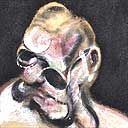March 22, 2007
Sometimes Even More So.

Edward Winkleman drove off the road at the end of his blogpost concerning Charlotte Higgens' Guardian cranky story about newly discovered trash from Francis Bacon's studio:
OK, so I realize there are two questions in there. First is whether the diary of a visual artist (something Higgins has mocked Robertson [and potential bidders] for valuing) is of historical and scholary value. In this instance, I'm sure Higgins is wrong. The diary of a visual artist is as equally important as that of a writer (sometime even more so).The answer to the first question also answers the second.The second question is more complex though: is damaged artwork valuable?
This blog is my diary. It's a virtual studio visit. I also call it a bibliographic aspect of my paintings. After the expansion of art media into a multitude of manifestations in the postmodern era, the impulse to sequester painting as Higgens did (and perhaps Winkleman too? -hard to tell right now) is very strange, if not quaint.
I think the question of the value of artist's studio detrius hinges on the depth of interest one has in the artist's ouevre. Sure, such interest can go astray and fetishing personality as Mr. Winkleman noted toward the end of his blogpost. But there is a difference between popular interest in an artist work that remains in the values circumscribed by the marketplace and a deeper interest that approaches a scholarly dimension which begins to transcend value itself.*
Actually, the latter leads the former. That's what the term "priceless" indicates.
*postscript: And as far as the latter versus former comparison goes, if it is the scholarly dimension that defines a museum... what are museums doing in the circumscribed and besotted market realm of contemporary art? What special formulation of their mission protects them from short-circuiting (destroying both the marketplace and the scholar's place along the way)? Maybe the auction houses should just eat the contemporary museum and be done with it. This may sound cranky, but why hang on to the identity of "museum" at all? Why not adopt the monniker of "kunsthalle" (or somesuch) and embrace the muddy water of the middle ground as the curatorial playground between the marketplace of the gallery world and the contemplative scholar's world of the museum?
Posted by Dennis at March 22, 2007 11:28 AM
Leave a comment